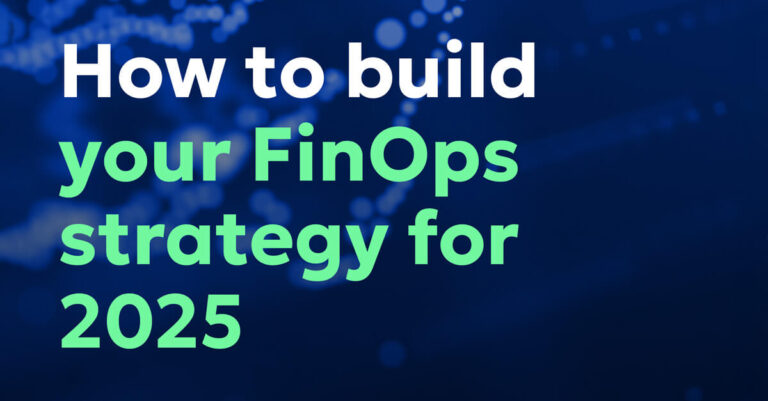
How To Build Your FinOps Strategy for 2025
As cloud infrastructure becomes increasingly crucial and inherent to business operations, the complexity and cost of managing cloud investments also rise, necessitating a strategic approach. FinOps has emerged as a framework designed to consolidate those strategic needs into a single streamlined process, emphasizing cost-efficiency and scalability of cloud infrastructure. With the advent of AI and the push towards sustainability, FinOps is critical for organizations aiming to optimize cloud spending while aligning with ecological goals.
This article provides an overview of FinOps best practices, offering recommendations for professionals to navigate the cloud landscape effectively in 2025.
Paving the Way for FinOps
As an operational framework, FinOps plays a critical role in maximizing the value organizations derive from their cloud investments. It emphasizes the importance of collaboration among finance, technology, and business teams to ensure cloud spending is in line with the company’s strategic goals. This integrated approach not only facilitates a culture of cost awareness and efficiency but also ensures that financial accountability is maintained across all levels of the organization.
Initiating a FinOps strategy begins with a dual approach: assessing current financial operations and engaging key stakeholders. Start by examining your cloud spending patterns and cost management tools. This assessment helps identify gaps and opportunities for improvement, setting a clear starting point for FinOps integration.
Simultaneously, involve key stakeholders from finance, IT, operations, and business units early on. Their collective insights are crucial for aligning FinOps practices with organizational goals, ensuring efficient cloud resource management, and minimizing waste. This collaboration lays the groundwork for a FinOps strategy that not only supports financial accountability and continuous improvement but also scales effectively with your organization’s growth.
By merging financial assessment with stakeholder engagement from the outset, you establish a robust foundation for your FinOps journey, poised for strategic alignment and operational efficiency.
FinOps Strategy: Objectives, Metrics, and Cost Optimization
Aligning FinOps objectives with broader business goals is crucial for ensuring that cloud spending contributes directly to the success of the organization. To effectively track the impact of FinOps practices, establishing clear metrics and Key Performance Indicators (KPIs) is vital. These metrics are essential tools for monitoring progress and guiding strategic decision-making.
Effective cost optimization within the FinOps framework involves a multi-faceted approach. Initially, it’s important to identify the primary drivers of cloud costs by analyzing usage patterns. This analysis sets the foundation for implementing targeted cost reduction strategies, such as right-sizing resources, utilizing reserved instances for predictable workloads, and eliminating underutilized resources. Moreover, a balance between cost and performance is essential. This holistic approach not only ensures that financial objectives are met but also drives operational excellence by maintaining high service quality.
Forecasting, Budgeting, and Managing Financial Risk
Effective financial management in the cloud hinges on a synergistic approach to forecasting and budgeting. This integrated process utilizes analytics and reporting tools to anticipate future cloud costs, providing the insights needed to allocate budgets with precision and foresight. By leveraging historical trends and current usage patterns, organizations can create a financial plan that not only meets their strategic objectives but also adapts to the dynamic nature of cloud spending.
Managing financial risk is integral to this process. It involves a proactive stance on identifying and mitigating potential financial threats, such as budget overruns or compliance penalties. This is achieved by strategies that include rightsizing resources, selecting optimal pricing models like Reserved Instances, and ensuring adherence to industry standards and regulations. Such measures not only control costs but also ensure that cloud investments are strategically sound and compliant.
By intertwining forecasting and budgeting with risk management, organizations can navigate the complexities of cloud financial management confidently. This holistic approach lays a strong foundation for financial stability, strategic planning, and compliance, ensuring that cloud investments contribute positively to the organization’s overall success.
Scaling Your FinOps Strategy
As organizations expand, the necessity to adapt and scale the FinOps strategy becomes paramount to effectively manage cloud costs and maintain financial efficiency. While a successful FinOps strategy can significantly contribute to a business’s growth, failing to consider scalability during the strategy’s initial formulation may eventually stifle that growth. Thus, ensuring the FinOps strategy evolves in tandem with the organization is crucial.
Key to scaling effectively is adaptability. A FinOps strategy must be flexible enough to adjust to organizational growth, market changes, and technological advancements. This adaptability ensures that cloud financial management remains aligned with the company’s evolving needs, supporting sustained growth and adaptation in a dynamic market environment. Additionally, maintaining agility in financial operations is essential. An agile FinOps approach allows for a rapid response to fluctuations in cloud usage and spending, underpinning strategic decision-making and enhancing operational efficiency.
Incorporating continuous improvement practices into the FinOps framework is another vital aspect. It involves regularly reviewing cloud usage and spending, soliciting feedback from relevant stakeholders, and evaluating the performance of the FinOps initiatives to identify areas for enhancement. By embedding these practices into the strategy, organizations ensure their FinOps framework remains robust and effective, thereby supporting sustainable growth and maintaining financial health in the long term.
FinOps and the Future of Sustainable Finance
As we look towards the future, the FinOps framework emerges as an indispensable guide for organizations navigating the complexities of cloud finance management. It champions cost efficiency, operational excellence, and strategic growth, ensuring businesses harness the full potential of the cloud while safeguarding financial health. Through principles like collaboration, visibility, agility, and optimization, FinOps equips organizations to manage cloud costs effectively and stay adaptable in the rapidly evolving digital landscape.
The emphasis on strategic financial planning, including forecasting and budgeting, highlights the importance of a proactive stance in cloud finance. As organizations aim to optimize their cloud investments and achieve strategic objectives, embracing the FinOps framework becomes crucial. It offers a structured pathway to not just operational excellence and financial efficiency but also to securing a competitive edge in the digital era, marking the journey towards success in cloud management.
For an in-depth exploration and practical advices to achieve the goals outlined in the article, read the full Ebook on our website.








